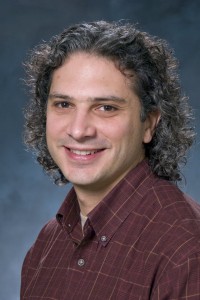
A visualization of a Vlasov-Poisson simulation for a bump-on-tail instability problem, where a non-equilibrium distribution of electrons drives an electrostatic wave. The image shows particle density as a function of space and velocity. (Jeffrey Hittinger, Lawrence Livermore National Laboratory.)
Lawrence Livermore National Laboratory (LLNL) computational scientist Jeffrey Hittinger spends his life at extremes. On the job, he focuses on the physics of plasmas – searing clouds of speedy ions and electrons – for fusion energy. Outside work, he tends goal for a San Francisco Bay-area amateur hockey team. Instead of simulating flying particles, he’s blocking or catching flying pucks.
His two interests share a fast pace – extraordinarily fast for plasmas – and a challenging nature. “I’m attracted to difficult things,” Hittinger says, then laughs. “I’m a goalie, so maybe I’m interested in difficult, high-pressure things.”
Likewise, “we get to work on hard problems” at the lab’s Center for Advanced Scientific Computing (CASC), Hittinger says. And like pucks flying in from unexpected directions, “there are always new problems coming at you.”
Hittinger, a Department of Energy Computational Science Graduate Fellowship (DOE CSGF) recipient from 1996 to 2000, creates and tweaks computer algorithms that emulate and elucidate aspects of some of the world’s most complex experiments.
“It’s a mixture of my background and what I stumbled into when I came to the lab,” Hittinger says. As a graduate student, he used gas kinetics to model fluid mechanics. Lab personnel recruited him to improve fluid plasma models for laser-driven inertial confinement fusion (ICF), the goal of the National Ignition Facility (NIF).
In NIF’s stadium-sized building, powerful lasers shoot into a hohlraum, a thimble-sized container holding a BB-sized capsule of frozen hydrogen isotopes. The laser pulse generates powerful X-rays, imploding the pellet with tremendous pressure and heat. The hydrogen atoms fuse, releasing energy in a process similar to that powering the sun.
“For ICF to work, you have to get a nice, clean implosion,” Hittinger says. “To do that, you need all the energy you’re putting into the system to go where you want it to go.” Plasma, however, can interact with the lasers, scattering or reflecting them.
Hittinger has helped improve laser-plasma interaction simulation codes, sometimes replacing or refining the hydrodynamic algorithms at their heart. He’s worked on adaptive mesh refinement (AMR) to focus computation on the most interesting areas, like where instabilities occur.
VALHALLA, one of Hittinger’s latest ICF projects, combines AMR with an efficient algorithm for solving the Vlasov-Poisson equations, which describe the self-consistent evolution of plasma particle distributions. The goal: cut the computational cost of simulations in phase space – up to three spatial and three velocity dimensions – to make such simulations practical. “We haven’t demonstrated yet that it’s absolutely going to give you a speedup” in computation, Hittinger says. That work continues.
Hittinger’s ICF work led him to magnetic confinement fusion, which trades a tiny pellet for a giant plasma cloud, hotter than the sun, swirling through a donut-shaped chamber called a tokamak. In the core, a magnetic field confines the plasma while radio waves heat it enough to strip away electrons and fuse hydrogen nuclei.
Hittinger works on kinetic models for the plasma edge, where the magnetic field doesn’t confine the plasma, which varies significantly. To be most efficient, the models’ computational grids should follow the magnetic field lines, Hittinger says. “Of course, the magnetic field is not a simple structure, especially in a tokamak and certainly not in an edge geometry.”
Nonetheless, COGENT, the code Hittinger is developing with researchers from LLNL and Lawrence Berkeley National Laboratory – including fellow DOE CSGF alumnus Daniel Martin – already has shown good agreement with some theoretical benchmarks. It uses high-order methods on mapped grids to solve the gyrokinetic Vlasov-Poisson equations, a plasma model suitable for an imposed magnetic field.
Besides his work on VALHALLA and COGENT, Hittinger’s also helped plan for the Fusion Simulation Program, a proposed multiyear, multi-institutional effort to develop a predictive, whole-device tokamak model. The project would couple codes portraying different physical properties, much as climate researchers join components into community models.
It’s a full plate for someone who didn’t picture himself at a national laboratory when he started graduate school. “If it weren’t for the CSGF, I probably wouldn’t have come to the lab,” Hittinger says. “I’m glad I did, because it fits my personality and my skill set. We do interdisciplinary things, and they’re hard problems. I don’t think there are many opportunities for that.”
